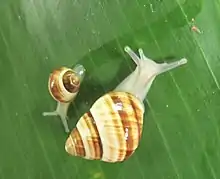| Achatinella fuscobasis | |
|---|---|
 | |
| Scientific classification | |
| Domain: | Eukaryota |
| Kingdom: | Animalia |
| Phylum: | Mollusca |
| Class: | Gastropoda |
| Subclass: | Heterobranchia |
| Order: | Stylommatophora |
| Family: | Achatinellidae |
| Genus: | Achatinella |
| Subgenus: | Bulimella |
| Species: | A. fuscobasis |
| Binomial name | |
| Achatinella fuscobasis (Smith, 1873) | |
| Synonyms | |
| |
Achatinella fuscobasis is a species of air-breathing land snail, a terrestrial pulmonate gastropod in the family Achatinellidae. This species is endemic to Hawaii.[3]
Shell description
The sinistral shell is ovate, with slightly convex whorls and the suture distinctly margined. The shell has six whorls. The color is glossy white with the last whorl yellowish and ornamented with a median zone and base of brown. The aperture is white and the brown peristome is thick. The columellar fold is strong.[4]
The height of the shell is 16.0 mm. The width of the shell is 10.0 mm.[4]
Distribution
In the wild these snails are found in high mountains, limited to only the Hawaiian island of Oahu. Their range is limited to around 100-250 square kilometers, with the majority being found on the leeward side of the Ko'olau Mountains.[5]
Diet
Achatinella's diet consists of microscopic colonies of black mold and fungi that are consumed using the snails radula. These mold layers grow on the leaves of vegetation and the feeding of them causes no damage to the plant itself.[6]
Conservation status
In 1996 the IUCN Red List ranked the species as critically endangered.[3] Since these snails reproduce slowly and only exist in a few limited locations, they are very vulnerable to threats. Habitat destruction for agriculture and invasive species are noted as the biggest reason for population decline, though fires, collecting, drought, hurricanes, logging and human recreation are also to blame.[5][7]
Threats from invasive species
Predation from a variety of introduced species is one of the most notable reasons for the dwindling populations.
Species at blame
- Rosy wolf snail - Euglandina rosea
- Garlic snail - Oxychilus alliarus
- Flatworm - Geoplana septemlineata
- Black rat - Rattus rattus
- Brown/Norway rat - Rattus norvegicus
- Polynesian rat - Rattus exulans
References
This article incorporates public domain text (a public domain work of the United States Government) from reference.[4]
- ↑ Hadfield, M.; Hadway, L. (1996). "Achatinella fuscobasis". IUCN Red List of Threatened Species. 1996: e.T183A13046554. doi:10.2305/IUCN.UK.1996.RLTS.T183A13046554.en. Retrieved 17 November 2021.
- ↑ "Appendices | CITES". cites.org. Retrieved 2022-01-14.
- 1 2 IUCN (1996-08-01). "Achatinella fuscobasis: Hadfield, M. & Hadway, L.: The IUCN Red List of Threatened Species 1996: e.T183A13046554". doi:10.2305/iucn.uk.1996.rlts.t183a13046554.en.
{{cite journal}}: Cite journal requires|journal=(help) - 1 2 3 U.S. Fish and Wildlife Service. (1992) Recovery Plan for the O’ahu Tree Snails of the Genus Achatinella. U.S. Fish and Wildlife Service, Portland, Oregon, 64 pp. + 64 pp. of appendices + 5 figures. PDF
- 1 2 "NatureServe Explorer 2.0". explorer.natureserve.org. Retrieved 2023-02-27.
- ↑ Stearns, Beverly Peterson (1999). Watching, from the edge of extinction. S. C. Stearns. New Haven, CT: Yale University Press. ISBN 0-585-35104-X. OCLC 47011675.
- ↑ "Achatinella". Division of Forestry and Wildlife: Native Ecosystems Protection & Management. 2020-12-29. Retrieved 2023-02-27.
